Abstract
Plant communities represent the integration of ecological and biological processes and they serve as an important component for the protection of biological diversity. To measure progress towards protection of ecosystems in the United States for various stated conservation targets we need datasets at the appropriate thematic, spatial, and temporal resolution. The recent release of the LANDFIRE Existing Vegetation Data Products (2016 Remap) with a legend based on U.S. National Vegetation Classification allowed us to assess the conservation status of plant communities of the U.S. The map legend is based on the Group level of the USNVC, which characterizes the regional differences in plant communities based on dominant and diagnostic plant species. By combining the Group level map with the Protected Areas Database of the United States (PAD-US Ver 2.1), we quantified the representation of each Group. If the mapped vegetation is assumed to be 100% accurate, using the Aichi Biodiversity target (17% land in protection by 2020) we found that 159 of the 265 natural Groups have less than 17% in GAP Status 1 & 2 lands and 216 of the 265 Groups fail to meet a 30% representation target. Only four of the twenty ecoregions have >17% of their extent in Status 1 & 2 lands. Sixteen ecoregions are dominated by Groups that are under-represented. Most ecoregions have many hectares of natural or ruderal vegetation that could contribute to future conservation efforts and this analysis helps identify specific targets and opportunities for conservation across the U.S.
1. Introduction
Ecologists have long recognized the importance of conserving biological diversity and the need for interdisciplinary approaches to address the challenge [1,2]. Myers [3] emphasized the potential for long-term evolutionary consequences of losing species and, in conjunction, recent research warns of the potential for ecosystem disruption as a result of species loss [4,5,6]. Over the last several decades, the scientific community worked to develop methods to quantify biodiversity [7,8] and to understand the threats to that diversity, including habitat loss [9], climate change [10], invasive species [11], disease [12] and interactions between multiple threats [13,14]. The international community has responded by coming together to establish the scientific basis for management and conservation actions at every level of organization (genes, species, ecosystems) [15] and to identify specific goals to help achieve sustainable development while maintaining biological diversity [16].
Measuring progress in conservation requires monitoring the extent and protection of the elements of biodiversity. For a global extent, a previous metric, the Aichi Target set in 2010 by the International Union for the Conservation of Nature (IUCN) was 17% of the lands and 10% of waters by 2020 [17]. Currently, IUCN’s 2030 Agenda includes the Sustainable Development Goal “Protect, restore and promote sustainable use of terrestrial ecosystems, sustainably manage forests, combat desertification, and halt and reverse land degradation and halt biodiversity loss” and a task force is working to establish new targets [16]. In the U.S. the 30 × 30 initiative has been recently established through a Presidential executive order [18]. This order directs the Secretary of the Department of Interior to establish a task force focused on achieving the conservation of 30% of the nation’s land and waters by the year 2030 [19]. There are a multitude of approaches to identifying lands that could be added to the conservation network; some focusing on abiotic factors [20,21], while others focus directly on biodiversity [22,23].
The U.S. Geological Surveys National Gap Analysis Project (GAP) was established with the specific mission of identifying species and vegetation types that are under-represented in the conservation network [24]. To assess representation, maps of protected areas, detailed land cover, and species habitat distribution models are created and combined to quantify protection of biodiversity elements within protected areas. The analysis allows us to understand not only how much of an element’s extent is in the network, but also who owns and manages the lands where it occurs [25]. To date, GAP analyses based on assessing the representation of plant communities have been completed for Puerto Rico [26], Hawai’i [27], for the southwestern U.S. [28], and for the conterminous U.S. [29].
In this analysis, we focus our assessment on plant communities as an effective method for characterizing ecosystems because they represented the integration of long-term biotic processes in the context of the abiotic environment [30]. In addition, they are important predictors of biodiversity [31,32] and are central to the GAP species habitat distribution modeling [33]. The classification system used to map and describe vegetation in the U.S. has evolved in response to stakeholder needs. Prior to 1997 there was no national standard for classifying vegetation [34]. Instead, agencies had developed classifications specific to a theme such as forest [35]; wetlands [36], habitats [37]; to a specific geography [38,39]; or to support general land use and land cover mapping [40]. In 1997 the Federal Geographic Data Committee Vegetation Subcommittee adopted the first U.S. National Vegetation Classification Standard (USNVC) [41]. That standard established the guidelines for a nationally consistent and hierarchical classification for all plant communities including natural, semi-natural and cultural vegetation. In 2008, a revision was made to the NVC Standard; that revision incorporated important changes in the hierarchical structure of the USNVC, following the EcoVeg approach [42,43,44]. That approach focuses on classifying plant communities based on the physiognomic (growth forms and structure), floristic (species composition) and ecological context (biogeography, climate, and disturbance regimes). One of the major changes in the new Standard was the addition of the middle levels—Division, Macrogroup and Group (Table 1, Figure 1). Those new levels provided an important linkage between the next higher level, Formation, defined primarily by physiognomy and the next lower level, Alliance, defined primarily by floristics.

Table 1.
U.S. National Vegetation 8-level hierarchy, criteria, and example types at each level. For these analyses we focused on the Formation Class and the Group levels of the hierarchy [42].
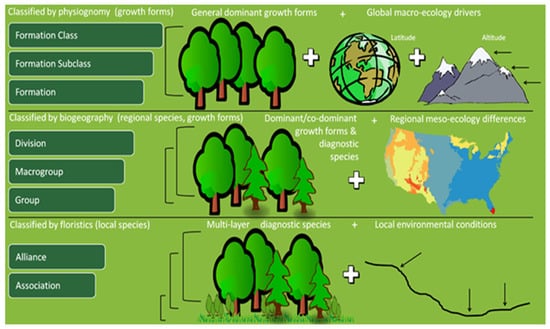
Figure 1.
Graphical representation of the U.S. National Vegetation Classification [42], showing the biotic and abiotic factors used to classify vegetation at each level of the hierarchy. Graphic designed by Curtis M. Belyea, North Carolina Cooperative Fish and Wildlife Research Unit.
With the release of the new Standard, the USNVC Hierarchy Revisions Working Group was tasked to complete a global set of upper formation level units for the USNVC Standard [42]. Development of the middle levels of the vegetation classification, Division, Macrogroup, and Group, was done through a broader partnership of experts who needed these units to support moderate resolution inventory and mapping efforts. Between 2012 and 2015, the Ecological Society of America (ESA) Panel on Vegetation Classification worked with the ESA Panel’s Editor in Chief, NatureServe Ecologists, and many state and federal ecologists to conduct a formal review and revision of the middle levels of the USNVC. In 2016, there was a formal release of vegetation types at all eight levels of the hierarchy for the conterminous U.S. (USNVC Ver 2.0).
Prior to the 2016 revisions to the USNVC, GAP and LANDFIRE relied on the Ecological Systems Classification System [45] which had been developed specifically to address the need for a vegetation classification system to support mapping. Over time, the two programs began collaborating on mapping vegetation with the goal of streamlining the process to support the goals of both GAP and LANDFIRE. In 2021, the LANDFIRE technical team released the first existing vegetation map for the conterminous U.S. based on the USNVC Group level classification [45], the finest level of the classification that could be mapped with moderate resolution imagery and captures important regional differences in natural vegetation types (Table 1, Figure 1).
Here we present the GAP analysis based on that Group level map and the most current version of the Protected Areas Database for the U.S. Ver 2.1. [46]. We were specifically interested in addressing four major questions:
- (1)
- How well represented are the natural Groups in the existing conservation network?
- (2)
- What are the spatial patterns of representation?
- (3)
- Where are opportunities for increasing representation? In other words, where are natural types outside the current conservation network and where are ruderal and plantation vegetation that might be restored to natural conditions? And
- (4)
- Which agencies are currently managing most of the nation’s vegetation resources?
2. Materials and Methods
The ecological models used to create the LANDFIRE Remap existing vegetation map are based on Landsat Enhanced Thematic Mapper Plus (ETM+) and Operational Land Imager (OLI) imagery, a suite of ancillary datasets (e.g., topography, climate, and soils) and the LANDFIRE Reference Database [47,48]. Seasonal image mosaics centered on 2016 were created using the USGS Earth Resources Observation and Science Center high performance computing systems and a best-pixel image compositing process [49] used to produce cloud-free image mosaics for each vegetation production unit area. Data from the National Land Cover Dataset [50] and National Agricultural Statistics Service Cropland Data Layer [51] were used in mapping non-natural classes such as developed and agricultural types.
To map natural and semi-natural (ruderal) vegetation, the LANDFIRE technical team assembled vegetation plot data in the LANDFIRE Reference Database [52]. There were over 700,000 plots available for mapping existing vegetation in the conterminous U.S. The technical team screened the plots for recent disturbances and spectral outliers, and labeled them with the dominant physiognomy (herbaceous, shrub, or tree) and assigned them to the USNVC Group using an auto-key process based on species cover or a crosswalk based on other community classification information provided with the plot. Labeled plots were used in a classification tree model to create masks for the herbaceous, shrub, and treed areas. For each of those areas a new round of models were created, this time the response variable was the Group label. Predictor variables included Landsat mosaics and derivatives and ancillary environmental variables. Specialized binary masks (e.g., sparsely vegetated, alpine, riparian) developed separately were used to map types in appropriate locations. The draft map for each vegetation production unit area was reviewed by several ecologists familiar with the area vegetation and when necessary post-processing was done to refine classes either by applying decision rules to relabel pixels or a new model was run if the concept of the type needed to be refined based on new information or additional plot data. For a full description of the LANDFIRE Remap methodology see Picotte et al. [47].
The final map of the conterminous U.S. contains 499 mapped land cover classes at 30-m resolution, including 287 Groups representing natural (265) and ruderal (22) vegetation; and one group, the Eastern North American Temperate Forest Plantation from the cultural vegetation classification. Our representation analyses focused on the 265 natural Groups. We organized that analysis based on the five Formation Classes; Forest and Woodland (120 Groups); Shrub and Herb Vegetation (99 Groups); Desert and Semi-Desert Vegetation (30 Groups); Polar and High Montane Scrub, Grassland & Barrens (8 Groups); and Open Rock Vegetation (8 Groups). For a list of Group membership in each of the Formation Classes see Table S2.
An initial assessment of the Group level map has been conducted based on a subset of 10% of the plot data that were set aside prior to the modeling work. The contingency tables can be found at the LANDFIRE Program’s website (LANDFIRE Program: Data Products—Data Quality—LF Remap EVT Agreement Assessment). The results of the assessment are preliminary and future assessment work is being discussed. While the plots were randomly selected from the plot database, they do not represent a stratified sampling across all types and geographies and therefore it is not possible to know the true precision of the mapping for all the Groups at this time. For our analyses, we assume that the map represents the best information available and take the next step in quantifying the level of representation at a national scale.
To quantify the representation of plant communities, we started with the LANDFIRE Remap 2016 (LF 2.0.0) USNVC product for the conterminous U.S. [53] and combined these data with the most recent version of the rasterized Protected Areas of the U.S. (PAD-US 2.01 [46], Table 2, Figure 2). Specifically, we used the ArcGIS Combine tool [54] to bring together the Group level map, the PAD-US management and GAP Status attributes, and a rasterized version of the Level II Environmental Protection Agency (EPA) Ecoregions [55]. We chose the EPA Ecoregions because they were found in the LANDFIRE’s prototyping work to provide ecologically meaningful boundaries that aligned with the distribution of natural vegetation types [48]. The resulting attribute table (Table 2) summarizes the unique combinations of Group, Management, GAP Status, and Ecoregion. Because the USNVC is truly hierarchical, we can use Table 2 to summarize information at coarser thematic resolutions of the classification (e.g., Macrogroup). The LANDFIRE snapshot of the USNVC descriptions dates to 2016 and we provide a linkage to the May 2021 version in Table S1.

Table 2.
GAP Status Codes (USGS GAP 2020).
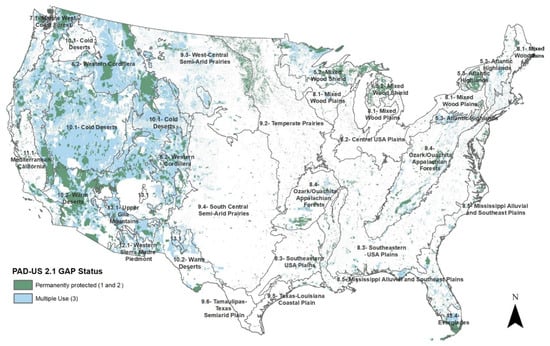
Figure 2.
Map of the distribution of Protected Areas of the U.S. (PAD-US 2.01 [46]) and Level II Ecoregions [55].
We assembled attributes from the spatial data in a coded workflow using Python© (version 3.6.5) and the Python Data Analysis Library© (version 1.1.2). The workflow is documented and available in a Jupyter notebook. We conducted analyses to quantify representation of plant communities throughout the conterminous U.S. Specifically, we compiled raster cell counts to summarize:
- Percent of mapped area designated protected (Status 1 & 2) and multiple use (Status 1, 2, & 3) for USNVC natural Groups across five USNVC Classes;
- Areal extent of protected (Status 1 & 2), and multiple use (Status 1, 2, & 3) of six USNVC Classes (natural, ruderal and plantation) by land manager (Bureau of Land Management, USDA Forest Service, National Park Service, US Fish & Wildlife Service, Other Federal, State, and Other); and
- Protection level (Status 1 & 2) of the natural USNVC Groups within four percentage categories (<1% Protected, 1–17% Protected, 17–30% Protected, >30% Protected) across Level II Ecoregions.
- Percentage of each Level II Ecoregion currently in Status 1 & 2 or 3 lands and the percentage Status 4 lands that has been converted to intensive uses (converted) or representing natural, ruderal or plantation vegetation (non-converted).
3. Results
3.1. Representation of Natural Groups in the Conservation Network
Representation of the individual natural USNVC Groups within the GAP Status 1 and 2 lands varies greatly from <1 to 90 percent (Figure 3; Table S2). When multiple use lands (Status 3) are included in the calculation there are a few groups with greater than 90 percent representation. The Groups in the Desert and Semi-Desert USNVC Class have the lowest mean (14%) representation in Status 1 and 2 lands, and the Groups in the Polar and High Montane Scrub, Grassland & Barrens Class have the highest (75%). Mean representation for Forest and Woodland Groups is 16%, Shrub and Herb Groups is 18%, and Open Rock Vegetation is 25%. Of the 265 Groups representing natural vegetation, 159 Groups had less than 17% of their distribution on Status 1 and 2 lands, and 216 Groups had less than 30% in protection. If multiple use lands are included 61 Groups still have less than 17% and 116 Groups have less than 30% of their mapped distribution within the Status 1, 2 & 3 lands.
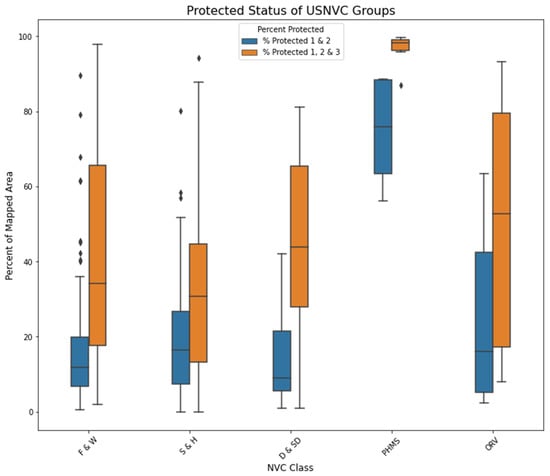
Figure 3.
Box plot showing the minimum, maximum and mean representation of United States National Vegetation Classification Groups within each of the five terrestrial vegetation USNVC Classes: F&W Forest and Woodland (120 Groups); S&H Shrub and Herb Vegetation (99 Groups); D&SD Desert and Semi-Desert Vegetation (30 Groups); PHMS Polar and High Montane Scrub, Grassland & Barrens (8 Groups); and ORV Open Rock Vegetation (8 Groups). Groups representing ruderal and plantation vegetation are not included in the analysis.
3.2. Spatial Patterns of Protection for USNVC Groups
The spatial patterns of representation of the mapped Groups in GAP Status 1 & 2, and 1, 2, & 3 lands are depicted in Figure 4. Areas of the Midwest dominated by human land use shown in gray are not included in our assessment. The ruderal and plantation types are mapped in pink. Notable locations of relatively high representation include the Everglades, the Warm Deserts, and portions of the Western Cordillera (Figure 4A). When the multiple use lands are included, the pattern in the west changes and in the Mixed Wood Shield of the upper Midwest, with now much more extensive representation (Figure 4B). Ruderal vegetation is concentrated in the Mediterranean California, the Cold Desserts, and South and Central Semi-Arid Plains Ecoregions. Ruderal and plantation vegetation is distributed more evenly throughout the Southeastern Plains, the South-Central Arid Prairies, and Temperate Prairies. Examples of some of the more extensive ruderal types include: Southeastern Native Ruderal Forest (G031); Southern Plains & Texas Ruderal & Planted Grassland & Shrubland (G680); Great Basin & Intermountain Ruderal Dry Shrubland & Grassland (G600); and California Ruderal Grassland & Forb Meadow (G497) (Table S2). Eastern North American Temperate Forest Plantation is mapped extensively throughout the Southeastern USA Plains.
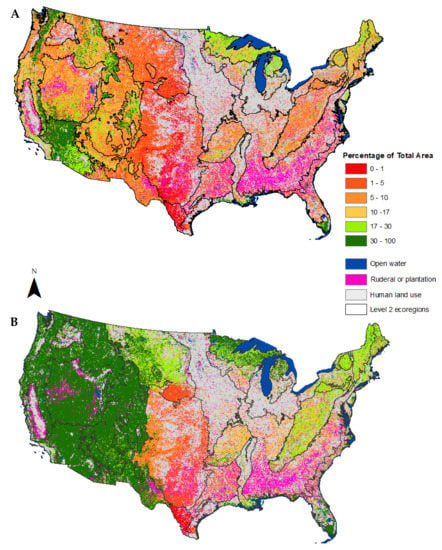
Figure 4.
Protection status designations are (A) lands managed to maintain biodiversity (Status 1 & 2) and (B) lands managed to maintain biodiversity and multiple-use (Status 1, 2, & 3) for the continental US. Percent area is based on the area of each United States National Vegetation Classification Group within each protection status divided by the total area of each of the natural USNVC Group across the conterminous U.S. Areas in pink represent ruderal and plantation vegetation and gray areas are intensively managed or urbanized land uses. Black borders represent the boundaries of the Level II Ecoregions [55].
3.3. Management by USNVC Class
Federal agencies manage over 1,631,537 km2 of natural vegetation in the conterminous U.S. based on converting the pixels counts to areal extent (Figure 5). Bureau of Land management (BLM) is responsible for managing over 540,000 km2 of Desert and Semi-Desert vegetation and the U.S. Forest Service manages nearly 500,000 km2 of Forest and Woodland vegetation. The majority of BLM and Forest Service lands are managed for multiple use. State agencies are responsible for managing over 145,000 km2 of Forest and Woodland and nearly 60,000 km2 of Shrub and Herb Vegetation and nearly 46,000 km2 of Desert and Semi-Desert Vegetation, respectively.
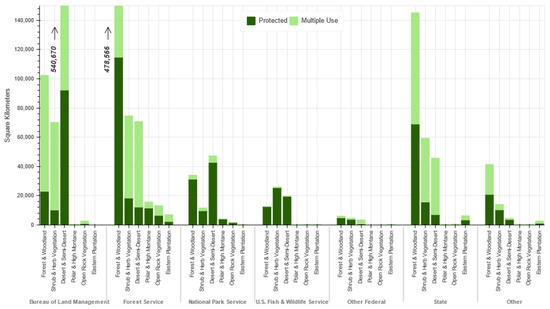
Figure 5.
Total area based on converting the mapped pixel count to area for each USNVC Class under management by federal, state, and other agencies. Ruderal types are included in the totals. The Eastern North American Temperate Forest Plantation (Eastern Plantation) from the cultural vegetation hierarchy are included as a separate bar. The category Other Federal includes agency lands such as Bureau of Reclamation, Department of Defense and Department of Energy. Other includes a variety of management such as American Indian Areas (Tribal lands), Non-Governmental Organization, Private, and local Agency lands.
3.4. Representation of USNVC Groups by Level II Ecoregion
When stratified by the intermediate ecoregion level, the majority of Groups have less than 17% of their mapped distribution in GAP Status 1 & 2 lands (Figure 6, Table S1). The ecoregions with the highest number of Groups with very low representation are the South Central Semi-Arid Prairies and the Tamaulipas-Texas Semiarid Plain, with 63 of 116 and 37 of 39 Groups with <1% representation respectively. The Warm Deserts and Western Cordillera ecoregions had the most Groups with over 30% representation (35 of 76 and 25 of 124 groups, respectively). In 16 of the 20 ecoregions, the majority of plant communities are under-represented at the 17% threshold. The Mixed Wood Shield, Everglades, Mississippi Alluvial and Southeast Coastal Plains, and Warm Deserts Ecoregions are the exceptions.
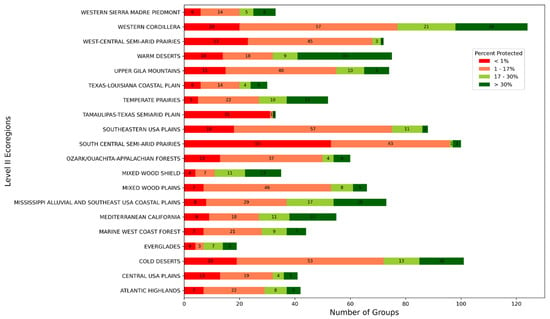
Figure 6.
Number of natural United States National Vegetation Classification Groups within one of four categories of representation within Status 1 and 2 lands by Ecoregion, For example, the Western Sierra Madre Piedmont Ecoregion had a total of 33 Groups that had been mapped within the ecoregion, of those 6 Groups had less than 1% of the mapped distribution in Status 1 and 2 Lands and 8 Groups had greater than 30% of their distribution in status 1 and 2 lands.
3.5. Distribution of GAP Status Designation by Level II Ecoregion
Four of the twenty ecoregions meet the 17% target for protection (Status 1 & 2), Specifically the Everglades, Mixed Wood Shield, Warm Deserts and Western Cordillera (Figure 7). None meet a 30% threshold. The Central USA Plains and Southeastern USA Plains have little protection and are dominated by intensive land use, whereas the South Central Semi-Arid Prairies and Tamaulipas-Texas Semi-Arid Plain Ecoregions have little protection but extensive non-converted vegetation. The percentage of Status 4 lands with non-converted vegetation varies greatly across ecoregions from a low of 13% in the Central USA Plains to as much as 79% in the Tamaulipas-Texas Semi-Arid Plain Ecoregion.
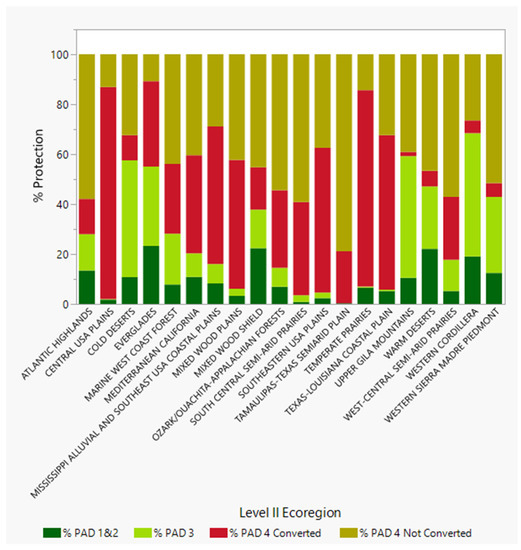
Figure 7.
Distribution of protected and unprotected land in each Level II ecoregion. “Not converted” represents lands with natural, ruderal or plantation vegetation on Status 4 lands. Converted lands are those in developed or agricultural classes. Open water was not included in the calculation of area.
4. Discussion
We chose the U.S. National Vegetation Classification to conduct our GAP analyses of ecosystem protection because it represents a national standard classification [41] and provides a common language for the natural resource agencies to communicate relative to management. In addition, it provides a hierarchical structure that links to global classification systems [56] and provides for meaningful scaling of classification units to meet the natural resource management needs of the end-users [34]. For example, the Groups represented in LANDFIRE Remap could be generalized to Macrogroups for an analysis at continental scales. At the same time, agencies such as the National Park Service can and have been collecting data, classifying, and mapping vegetation on their lands at the finest levels of the USNVC classification, the Alliance and Association [57]. The hierarchy allows for meaningful scaling of the resolution while maintaining the important ecological context necessary for management decisions.
This analysis is based on three nationally consistent datasets (LANDFIRE Existing Vegetation, Protected Areas Database of the U.S. and the USNVC) and could provide the base for monitoring success in meeting conservation targets through time. The three datasets used in this analysis are the culmination of years of data development, expert review and refinement of the methods, and they represent the best available information at a national extent for each of the themes (plant communities, protected areas and vegetation classification). However, no dataset is without error, so these analyses should be treated as a general guide for identifying specific conservation actions. In addition, not all USNVC Groups were mappable using LANDFIRE methods, and additional methods are needed to ensure their representation. As we learn more about novel and previously undescribed plant communities, we will need to incorporate that knowledge in future assessments. Although there are hundreds of thousands of plots describing vegetation, those data are generally not the result of a systematic sampling and therefore many vegetation types and geographies are under-surveyed. Ideally those gaps in the data will be filled through a nationally coordinated effort and through continued collaborations with ecologists across the U.S.
Finally, we note, as Scott et al. [24] did, namely that a Gap Analysis is not a substitute for a thorough ecological inventory and assessment of the nation’s ecosystems. Understanding the drivers that affect the ecological condition of ecosystems, both within and beyond the protected area boundaries, will be essential to ensuring the persistence of natural ecosystems in these protected areas.
While the analysis is relatively straightforward, it does identify specific plant communities and ecoregions that are currently under-represented in the conservation network. We do not attempt to prescribe methods for expanding the network, although our analysis does provide some of the potential targets for those decisions. Criteria on threats and intactness [58,59] or habitats for potentially rare species [25] or climate refugia [20] could be used in combination with this analysis to refine the list of proposed actions while at the same time making sure the actions could benefit biodiversity throughout the U.S. In addition, our assessment treats all ecosystems as of equal interest; it may also be helpful to evaluate the protection status of those ecosystems most at risk [60].
5. Conclusions
While the raw percentage of land in the conservation network could be used as metric of success, we chose to use plant communities, at a level of thematic resolution that would ensure regional stratification of protection, the USNVC Groups. By capturing the full range of natural vegetation at the Group level in the conservation network we are more likely to conserve the full range of biogeographic variation and to provide for conserving a full range of habitats across the country. Relative to the Aichi target of 17%, our analysis indicates that the majority of natural plant communities in the U.S. are currently under-represented on Status 1 & 2 lands. As with other studies in the U.S., we show there is a spatial bias in the distribution of the protected lands [25,29,61] and therefore variation in the level of protection for a regionally specific element of biodiversity is high. Groups within the Polar and High Montane Scrub, Grassland and Barrens Class are well represented in the conservation network, while the mean representation for groups in the Forest and Woodland and Desert and Semi-Desert Vegetation fall below the 17% threshold. The mean for the Groups in the Shrub and Herb Vegetation and Open Rock Vegetation are slightly above the Aichi target but below 30%.
At the ecoregional extent, the majority of natural USNVC Groups are underrepresented. Our analysis shows that while a few ecoregions have low potential for adding to representation, there are ecoregions where the extent and distribution of natural, ruderal and plantation vegetation represents conservation opportunities for increasing representation.
Supplementary Materials
The following are available online at https://www.mdpi.com/article/10.3390/f12070864/s1, Table S1: AppendixA_Groups2016_2021.csv, Table S2: AppendixB_GroupRepresentation.csv.
Author Contributions
Conceptualization, A.M., M.R., A.D. and D.F.-L.; methodology, A.M., M.R. and A.D.; formal analysis, A.M., M.R. and A.D.; data curation, A.D. and M.R.; writing—original draft preparation, A.M.; writing—review and editing, D.F.-L., D.D., M.R. and A.D.; visualization, A.D. and M.R All authors have read and agreed to the published version of the manuscript.
Funding
Funding for this research was provided by the U.S. Geological Survey’s Science Synthesis, Analysis, and Research Program.
Data Availability Statement
Data and appendices will be made available the U.S. Geological Surveys ScienceBase Repository. McKerrow, A., Davidson, A., and Rubino, M. 20210520, U.S. National Vegetation Classification Group Gap Analysis Data: U.S. Geological Survey, https://doi.org/10.5066/P93H6RIS.
Acknowledgments
The authors would like to acknowledge the work of Lisa Johnson and Mason Croft of Boise State University’s Department of Public Policy and Administration for their work on the Protected Areas Database of the U.S.; Kristin Snow of NatureServe for help on the USNVC Classification; the Ecological Society of America Panel on Vegetation Classification for their help in the development of the USNVC, the LANDFIRE Technical Team for the mapping efforts and Curtis Belyea for his help with graphics and the data documentation. We would also like to thank the four reviewers who provided helpful feedback on the earlier versions of this paper. Any use of trade, firm, or product names is for descriptive purposes only and does not imply endorsement by the U.S. Government.
Conflicts of Interest
The authors declare no conflict of interest.
References
- Soule, M.E. What is conservation biology? Bioscience 1985, 35, 727–734. Available online: https://www.jstor.org/stable/1310054 (accessed on 21 June 2021).
- Wu, J. Thirty years of Landscape Ecol. (1987–2017): Retrospects and prospects. Landsc. Ecol. 2017, 32, 2225–2239. [Google Scholar] [CrossRef] [Green Version]
- Myers, N. The biodiversity crisis and the future of evolution. Environmentalist 1996, 16, 37–47. [Google Scholar] [CrossRef]
- Pires, A.P.F.; Srivastava, D.S.; Marino, N.A.C.; MacDonald, A.A.M.; Figueiredo-Barros, M.P.; Farjalla, V.F. Interactive effects of climate change and biodiversity loss on ecosystem functioning. Ecology 2018, 99, 1203–1213. [Google Scholar] [CrossRef] [PubMed]
- Hooper, D.U.; Adair, E.C.; Cardinale, B.J.; Byrnes, J.E.K.; Hungate, B.A.; Matulich, K.L.; Gonzalez, A.; Duffy, J.E.; Gamfeldt, L.; O’Connor, M.I. A global synthesis reveals biodiversity loss as a major driver of ecosystem change. Nature 2012, 486, 105–108. [Google Scholar] [CrossRef]
- Trisos, C.H.; Merow, C.; Pigot, A.L. The projected timing of abrupt ecological disruption from climate change. Nature 2020, 580, 496–501. [Google Scholar] [CrossRef]
- Gotelli, N.J.; Colwell, R.K. Quantifying biodiversity: Procedures and pitfalls in the measurement and comparison of species richness. Ecol. Lett. 2001, 4, 379–391. [Google Scholar] [CrossRef] [Green Version]
- Orme, C.D.L.; Davies, R.G.; Burgess, M.; Eigenbrod, F.; Pickup, N.; Olson, V.A.; Webster, A.J.; Ding, T.-S.; Rasmussen, P.C.; Ridgely, R.S.; et al. Global hotspots of species richness are not congruent with endemism or threat. Nature 2005, 436, 1016–1019. [Google Scholar] [CrossRef]
- Laurance, W.F.; Lovejoy, T.E.; Vasconcelos, H.L.; Bruna, E.M.; Didham, R.K.; Stouffer, P.C.; Gascon, C.; Bierregaard, R.O.; Laurance, S.G.; Sampaio, E. Ecosystem decay of Amazonian forest fragments: A 22-Year Investigation. Conserv. Biol. 2002, 16, 605–618. [Google Scholar] [CrossRef] [Green Version]
- Thomas, C.D.; Cameron, A.; Green, R.E.; Bakkenes, M.; Beaumont, L.J.; Collingham, Y.C.; Erasmus, B.F.N.; de Siqueira, M.F.; Grainger, A.; Hannah, L.; et al. Extinction risk from climate change. Nature 2004, 427, 145–148. [Google Scholar] [CrossRef]
- McNeely, J. Invasive species: A costly catastrophe for native biodiversity. Land Use Water Resour. Res. 2001, 2, 1–10. [Google Scholar]
- Murray, K.A.; Retallick, R.W.R.; Puschendorf, R.; Skerratt, L.F.; Rosauer, D.; McCallum, H.I.; Berger, L.; Speare, R.; VanDerWal, J. Assessing spatial patterns of disease risk to biodiversity: Implications for the management of the amphibian pathogen, Batrachochytrium dendrobatidis. J. Appl. Ecol. 2011, 48, 163–173. [Google Scholar] [CrossRef]
- Mantyka-Pringle, C.S.; Visconti, P.; Di Marco, M.; Martin, T.G.; Rondinini, C.; Rhodes, J.R. Climate change modifies risk of global biodiversity loss due to land-cover change. Biol. Conserv. 2015, 187, 103–111. [Google Scholar] [CrossRef] [Green Version]
- Pardini, R.; Nichols, L.; Püttker, T. Biodiversity response to habitat loss and fragmentation. In Encyclopedia of the Anthropocene; DellaSalla, D., Goldstein, M., Eds.; Elsevier: Waltham, MA, USA, 2018; Volume 3, pp. 229–241. [Google Scholar] [CrossRef]
- Millennium Ecosystem Assessment. Ecosystems and Human Well-being: Biodiversity Synthesis; World Resources Institute: Washington, DC, USA, 2005; 100p. [Google Scholar]
- IUCN. Nature 2030: One Nature, One Future: A Programme for the Union 2021–2024; International Union for Conservation of Nature; World Conservation Congress: Gland, Switzerland, 2021; 24p. [Google Scholar]
- Convention on Biological Diversity. Strategic Plan for Biodiversity Including Aichi Biodiversity Targets 2011–2020; Convention on Biological Diversity: Montreal, QC, Canada, 2010. [Google Scholar]
- United States, Executive Office of the President. (Biden, J.R., Jr.). Executive Order 14008: Tackling the Climate Crisis at Home and Abroad; United States, Executive Office of the President: Washigton, DC, USA, 2021. [Google Scholar]
- National Climate Task Force. Conserving and Restoring America the Beautiful 2021. Available online: https://www.doi.gov/sites/doi.gov/files/report-conserving-and-restoring-america-the-beautiful-2021.pdf (accessed on 21 June 2021).
- Lawler, J.J.; Rinnan, D.S.; Michalak, J.L.; Withey, J.C.; Randels, C.R.; Possingham, H.P. Planning for climate change through additions to a national protected area network: Implications for cost and configuration. Philos. Trans. R. Soc. B 2020, 375, 20190117. [Google Scholar] [CrossRef] [Green Version]
- Anderson, M.G.; Ferree, C.E. Conserving the stage: Climate change and the geophysical underpinnings of species diversity. PLoS ONE 2010. [Google Scholar] [CrossRef]
- Belote, R.T.; Dietz, M.S.; Jenkins, C.N.; McKinley, P.S.; Irwin, G.H.; Fullman, T.J.; Leppi, J.C.; Aplet, G.H. Wild, connected, and diverse: Building a more resilient system of protected areas. Ecol. Appl. 2017, 27, 1050–1056. [Google Scholar] [CrossRef]
- Scott, J.M.; Davis, F.W.; McGhie, R.G.; Wright, R.G.; Groves, C.; Estes, J. Nature reserves: Do they capture the full range of america’s biological diversity? Ecol. Appl. 2001, 11, 999–1007. [Google Scholar] [CrossRef]
- Scott, J.M.; Davis, F.; Csuti, B.; Noss, R.; Butterfield, B.; Groves, C.; Anderson, H.; Caicco, S.; D’Erchia, F.; Edwards, T.C., Jr.; et al. Gap analysis: A geographic approach to protection of biological diversity. Wildl. Monogr. 1993, 123, 3–41. [Google Scholar]
- Davidson, A.; Dunn, L.; Gergely, K.; McKerrow, A.; Williams, S.; Case, M. Refining the coarse filter approach: Using habitat-based species models to identify rarity and vulnerabilities in the protection of U.S. biodiversity. Glob. Ecol. Conserv. 2021. [Google Scholar] [CrossRef]
- Gould, W.A.; Alarcón, C.; Fevold, B.; Jiménez, M.E.; Martinuzzi, S.; Potts, G.; Quiñones, M.; Solórzano, M.; Ventosa, E. The Puerto Rico Gap Analysis Project. Volume 1: Land Cover, Vertebrate Species Distributions, and Land Stewardship; Gen. Tech. Rep. IITF-GTR-39; U.S. Department of Agriculture, Forest Service, International Institute of Tropical Forestry: Río Piedras, Puerto Rico, 2008; 165p. [Google Scholar]
- Gon, S.M., III; Allison, A.; Cannarella, R.J.; Jacobi, J.D.; Kaneshiro, K.Y.; Kido, M.H.; Lane-Kamahele, M.; Miller, S.E. The Hawai‘i GAP Analysis Final Report; Report, U.S. Department of Interior, U.S. Geological Survey: Washigton, DC, USA, 2006; 162p. [Google Scholar]
- Boykin, K.G.; Stoner, L.L.; Lowry, J.H.; Schrupp, D.L.; Bradford, D.F.; O’Brien, L.; Thomas, K.A.; Drost, C.; Ernst, A.E.; Kepner, W.J.; et al. Analysis based on stewardship and management status. In Southwest Regional Gap Analysis Final Report; U.S. Geological Survey, Gap Analysis Program: Washington, DC, USA, 2007; Chapter 5. [Google Scholar]
- Aycrigg, J.L.; Davidson, A.; Svancara, L.K.; Gergely, K.J.; McKerrow, A.J.; Scott, J.M. Representation of ecological systems within the protected areas network of the continental United States. PLoS ONE 2013, 8, e54689. [Google Scholar] [CrossRef] [Green Version]
- Whittaker, R.H. Communities and Ecosystems, 2nd ed.; MacMillan: New York, NY, USA, 1975; p. 385. [Google Scholar]
- Franklin, J.F. Preserving Biodiversity: Species, Ecosystems, or Landscapes? Ecol. Appl. 1993, 3, 202–205. [Google Scholar] [CrossRef] [PubMed] [Green Version]
- Noss, R.F. Indicators for monitoring biodiversity: A hierarchical approach. Conserv. Biol. 1990, 4, 355–364. [Google Scholar] [CrossRef]
- Gergely, K.J.; Boykin, K.G.; McKerrow, A.J.; Rubino, M.J.; Tarr, N.M.; Williams, S.G. Gap Analysis Project (GAP) Terrestrial Vertebrate Species Richness Maps for the Conterminous U.S.; U.S. Geological Survey Scientific Investigations Report 2019–5034; Gap Analysis Program: Washington, DC, USA, 2019; 99p. [Google Scholar] [CrossRef] [Green Version]
- Franklin, S.; Faber-Langendoen, D.; Jenning, S.M.; Keeler-Wolf, T.; Loucks, O.; Peet, R.; Roberts, D.; McKerrow, A. Building the United States national vegetation classification. Ann. Bot. 2012, 2, 1–9. [Google Scholar]
- Eyre, F.H. Forest Cover Types of the United States and Canada; Society of American Foresters: Washington, DC, USA, 1980; p. 148. [Google Scholar]
- Cowardin, L.M.; Carter, V.; Golet, F.C.; LaRoe, E.T. Classification of Wetlands and Deepwater Habitats of the United States; FWS/OBS-79/31; U.S. Fish and Wildlife Service: Washington, DC, USA, 1979. [Google Scholar]
- Brown, D.E. Biotic Communities of the American Southwest-United States and Mexico. Desert Plants 1982, 4, 1–342. [Google Scholar]
- Madden, M.; Jones, D.; Vilchek, L. Photointerpretation key for the Everglades Vegetation Classification System. Photogramm. Eng. Remote Sens. 1999, 65, 171–177. [Google Scholar]
- Brown, D.E. A system for classifying cultivated and cultured lands within a systematic classification of natural ecosystems. J. Ariz. Nev. Acad. Sci. 1980, 15, 4853. Available online: https://www.jstor.org/stable/40024073 (accessed on 21 June 2021).
- Anderson, R.J.; Hardy, E.E.; Roach, J.T.; Witmer, R.E. A Land Use and Land Cover Classification System for Use with Remote Sensor Data; U.S. Geological Survey Professional Paper 964; U.S. Geological Survey: Washigton, DC, USA, 1976; 28p. [Google Scholar]
- Federal Geographic Data Committee. Vegetation Subcommittee. Vegetation Classification Standard; FGDC-STD-005; U.S. Geological Survey, Federal Geographic Data Committee, Vegetation Subcommittee: Reston, VA, USA, 1997. Available online: http://www.fgdc.gov/standards/documents/standards/vegetation/vegclass.pdf (accessed on 21 June 2021).
- Federal Geographic Data Committee. Vegetation Subcommittee. National Vegetation Classification Standard, Version 2; FGDC-STD-005-2008; Federal Geographic Data Committee, U.S. Geological Survey: Reston, VA, USA, 2008. Available online: http://www.fgdc.gov/standards/documents/standards/vegetation/vegclass.pdf (accessed on 21 June 2021).
- Faber-Langendoen, D.; Keeler-Wolf, T.; Meidinger, D.; Tart, D.; Hoagland, B.; Josse, C.; Navarro, G.; Ponomarenko, S.; Saucier, J.-P.; Weakley, A.; et al. EcoVeg: A new approach to vegetation description and classification. Ecol. Monogr. 2014, 84, 533–561. [Google Scholar] [CrossRef]
- Faber-Langendoen, D.; Keeler-Wolf, T.; Meidinger, D.; Josse, C.; Weakley, A.; Tart, D.; Navarro, G.; Hoagland, B.; Ponomarenko, S.; Fults, G.; et al. Classification and Description of World Formation Types; Gen. Tech. Rep. RMRS-GTR-346; U.S. Department of Agriculture, Forest Service, Rocky Mountain Research Station: Fort Collins, CO, USA, 2016; 222p. [Google Scholar]
- Comer, P.; Faber-Langendoen, D.; Evans, R.; Gawler, S.; Josse, C.; Kittel, G.; Menard, S.; Pyne, M.; Reid, M.; Schulz, K.; et al. Ecological Systems Of The United States: A Working Classification of U.S. Terrestrial Systems; NatureServe: Arlington, VA, USA, 2003. [Google Scholar]
- U.S. Geological Survey (USGS) Gap Analysis Project (GAP), 2020. Protected Areas Database of the United States (PAD-US) 2.1: U.S. Geological Survey Data Release. Available online: https://doi.org/10.5066/P92QM3NT (accessed on 21 June 2021).
- Picotte, J.J.; Dockter, D.; Long, J.; Tolk, B.; Davidson, A.; Peterson, B. LANDFIRE Remap Prototype Mapping Effort: Developing a New Framework for Mapping Vegetation Classification, Change, and Structure. Fire 2019, 2, 35. [Google Scholar] [CrossRef] [Green Version]
- Dockter, D.; Callahan, K.; Tolk, B.; Peterson, B. LANDFIRE Remap: Improvements in national ecosystem modeling and vegetation mapping. In Proceedings of the Ecological Society of America Annual Meeting, Virtual Meeting, 3–6 August 2020. [Google Scholar]
- Nelson, K.J.; Steinwand, D. A Landsat data tiling and compositing approach optimized for change detection in the conterminous United States. Photogramm. Eng. Remote Sens. 2015, 81, 13–26. [Google Scholar] [CrossRef]
- Yang, L.; Jin, S.; Danielson, P.; Homer, C.; Gass, L.; Bender, S.M.; Case, A.; Costello, C.; Dewitz, J.; Fry, J.; et al. A new generation of the United States National Land Cover Database: Requirements, research priorities, design, and implementation strategies. ISPRS J. Photogramm. Remote Sens. 2018, 146, 108–123. [Google Scholar] [CrossRef]
- Boryan, C.; Yang, Z.; Mueller, R.; Craig, M. Monitoring US agriculture: The US Department of Agriculture, National Agricultural Statistics Service, Cropland Data Layer Program. Geocarto Int. 2011, 26, 341–358. [Google Scholar] [CrossRef]
- Caratti, J.F. The LANDFIRE prototype project reference database. In The LANDFIRE Prototype Project: Nationally Consistent and Locally Relevant Geospatial Data for Wildland Fire Management; Rollins, M.G., Frame, C., Eds.; Gen. Tech. Rep. RMRS-GTR-175; Department of Agriculture, Forest Service Rocky Mountain Research Station: Fort Collins, CO, USA, 2006; pp. 69–98. [Google Scholar]
- LANDFIRE. USGS Earth Resources Observation and Science Center (EROS), U.S. Geological Survey. LANDFIRE Remap 2016 National Vegetation Classification (NVC) CONUS. 2020. Available online: https://www.landfire.gov (accessed on 24 February 2021).
- Environmental Systems Research Institute. ArcGIS 10.7 Spatial Analyst Toolbox. What is the ArcGIS Spatial Analyst Extension?—ArcGIS Help|Documentation. Available online: https://desktop.arcgis.com/en/arcmap/10.7/tools/spatial-analyst-toolbox/an-overview-of-the-spatial-analyst-toolbox.htm (accessed on 21 June 2021).
- Omernik, J.M.; Griffith, G.E. Ecoregions of the conterminous United States: Evolution of a hierarchical spatial framework. Environ. Manag. 2014, 54, 1249–1266. [Google Scholar] [CrossRef]
- Faber-Langendoen, D.; Baldwin, K.; Keeler-Wolf, T.; Meidinger, D.; Muldavin, E.; Peet, R.K.; Josse, C. The EcoVeg Approach in the Americas: U.S., Canadian, and International Vegetation Classifications. Phytocoenologia 2018, 48, 215–237. [Google Scholar] [CrossRef]
- Lea, C. Vegetation Classification Guidelines: National Park Service Vegetation Inventory, Version 2.0. 2001; Natural Resource Report NPS/NRPC/NRR—2011/374; National Park Service: Fort Collins, CO, USA, 2021. [Google Scholar]
- Hak, J.C.; Patrick, J.; Comer, P.J. Modeling landscape condition for biodiversity assessment—Application in temperate North America. Ecol. Ind. 2017, 82, 206–216. [Google Scholar] [CrossRef]
- Aycrigg, J.L.; Tricker, J.; Travis Belote, R.; Dietz, M.S.; Duarte, L.; Aplet, G.H. The Next 50 Years: Opportunities for Diversifying the Ecological Representation of the National Wilderness Preservation System within the Contiguous United States. J. For. 2016, 114, 396–404. [Google Scholar] [CrossRef]
- NatureServe. The Status of Biodiversity in the United States; NatureServe: Arlington, VA, USA, 2021. [Google Scholar]
- Jenkins, C.; Van Houtan, K.; Pimm, S.; Sexton, J. US protected lands mismatch biodiversity priorities. Proc. Natl. Acad. Sci. USA 2015, 112, 5081–5086. [Google Scholar] [CrossRef] [Green Version]
Publisher’s Note: MDPI stays neutral with regard to jurisdictional claims in published maps and institutional affiliations. |
© 2021 by the authors. Licensee MDPI, Basel, Switzerland. This article is an open access article distributed under the terms and conditions of the Creative Commons Attribution (CC BY) license (https://creativecommons.org/licenses/by/4.0/).